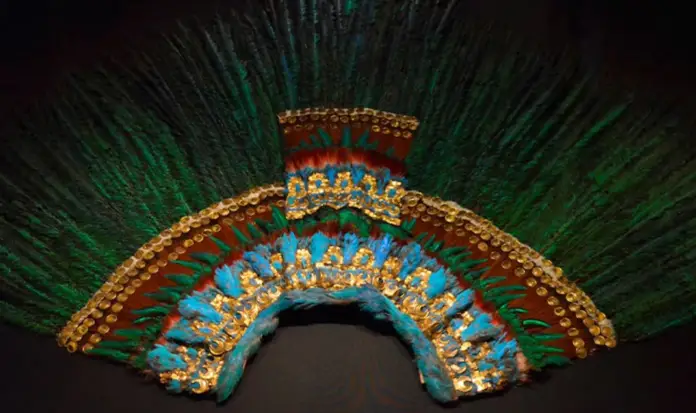For decades, the Mexican government has requested the return of Moctezuma’s headdress from Austria, but European authorities have denied the possibility of its transfer. For this reason, a contemporary reinterpretation of the headdress that the Aztec tlatoani used to wear, made with modern materials and traditional techniques, is on display at the National Museum of Anthropology (MNA) in Mexico City.
The piece, created by textile designer Valeria Corona, seeks to pay homage to the emblematic headdress of the Aztec tlatoani, who saw his empire fall at the arrival of Hernán Cortés and his army of conquistadors.
The exhibition, titled The Headdress of Modern Mexico, opened on Friday, February 7, 2025, and will remain open to the public until February 16, 2025.
This modern work is presented as a symbolic effort to return the cultural meaning of the headdress to its place of origin, as the original object, made of bird feathers and gold ornaments, is currently in the Ethnological Museum of Vienna, Austria.
The contemporary piece, which measures 130 by 220 centimeters and weighs 17 kilograms, was made with materials such as black sheet metal, acrylic, LED light nodes, and aluminum.
Both traditional and innovative techniques were used to create it. Master craftsman Gerardo Hermosillo used the traditional metalworking method of chopping, while specialist Gustavo Rojas applied laser cutting technology.
This dual approach allowed the work to become a bridge between the artisanal practices of indigenous peoples and contemporary tools.
The production process was carried out in an industrial warehouse located in San Antonio Cacalotepec, in the municipality of San Andrés Cholula, Puebla. This space was provided by Lidia Morales, producer of the project, who highlighted the importance of having an adequate place to integrate the different techniques and materials that shaped the work.
Inspiration in Mesoamerican thought
Designer Valeria Corona explained that her work was inspired by the words of architect Pedro Ramírez Vázquez, who stated that a Mesoamerican artist would act using current materials.
Under this premise, Corona sought to build a dialogue between light, traditional techniques and modern tools, creating a work that connects generations and cultures. According to the INAH, the installation does not intend to be a replica of the original feather art, but rather a reinterpretation that highlights the symbolism and aesthetics of the plume.

Source: infobae




